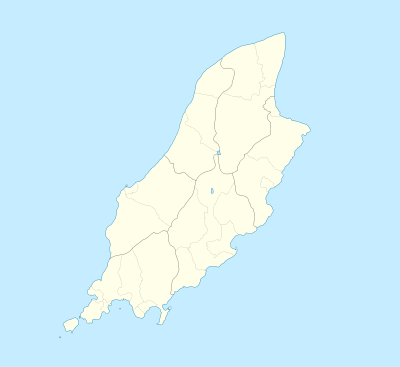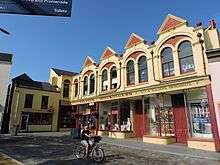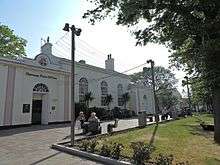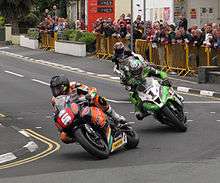Ramsey, Isle of Man
| Ramsey | |
| Manx: Rhumsaa | |
| Ramsey Quayside and fishing boats |
|
 Ramsey |
|
| Population | 7,309 (2006 Census) |
|---|---|
| OS grid reference | SC449943 |
| – Douglas | 15 miles (24 km) |
| Parish | Ramsey |
| Sheading | Ayre |
| Crown dependency | Isle of Man |
| Post town | ISLE OF MAN |
| Postcode district | IM8 |
| Dialling code | 01624 |
| Police | Isle of Man |
| Fire | Isle of Man |
| Ambulance | Isle of Man |
| House of Keys | Ramsey Town |
|
|
Coordinates: 54°19′16″N 4°23′04″W / 54.321111°N 4.384444°W
Ramsey (Manx: Rhumsaa) is a coastal town in the north of the Isle of Man. It is the second largest town on the island after Douglas. Its population is 7,309 according to the 2006 census (7,322, 2001 census). It has one of the biggest harbours on the island, and has a prominent derelict pier, called the Queen's Pier. It was formerly one of the main points of communication with Scotland. Ramsey has also been a route for several invasions by Vikings and Scots.
Ramsey is also known as 'Royal Ramsey' due to royal visits from Queen Victoria and Prince Albert in 1847 followed by King Edward VII and Queen Alexandra in 1907.[1]
History
The name of the town derives from the Old Norse hrams-á, meaning "wild garlic river",[2] More specifically, it refers to the plant known as buckrams or wild garlic, in Latin Allium ursinum.
The Isle of Man has been an important strategic location in conflicts between the Norse rulers of Man and the Isles, and the Scots and English. Smugglers and pirates were also common at many times in Manx history.
Ramsey was the landing place of the Viking warrior Godred Crovan around 1079: he was determined to subjugate the island and make it his kingdom. Two miles inland, on Sky Hill, an important battle was fought; this resulted in several hundred years of Viking rule, influencing the development of the Manx nation and many of the traditions that continue today.
Godred's son, King Olaf, was murdered by his nephew Reginald near Ramsey harbour in 1154.
On 17 May 1313 Robert the Bruce landed at Ramsey "with a multitude of ships" on his way to capturing Castle Rushen.
Captain François Thurot, a then-famous French privateer, and notorious scourge of the British fleet, was defeated off the north-west of the Island in February 1760. His badly damaged, captured ship was brought into Ramsey Bay after the battle. Thurot's actions had been part of a planned French invasion of Britain. In previous years Thurot had traded between Ireland and the Isle of Man and had been well liked by many Manx: regarded as an intelligent gentleman. Several cottages and bridges were built using timbers from the wrecked ship: hence 'Thurot Cottage' and Thurot Bridge.
Pirate radio station Radio Caroline North was based in Ramsey Bay from 1964–68 and supplied with provisions from Ramsey.
During World War II, thirty boarding houses on the North Shore were requisitioned for the Mooragh Internment Camp.
Climate and geography
Ramsey is in the sunniest area of the Isle of Man, with relatively low rainfall. This is because Ramsey is in a 'rain shadow' just to the north of the Manx hills, on the edge of the northern plain of the island. Rain clouds coming from the prevailing wind direction, the south-west tend to lose most of their moisture on the hills before they reach Ramsey.
Ramsey is built mostly on sandy ground and has miles of sandy beaches. To the north of Ramsey the beaches run continuously to the north tip of the island. On the southern edge of Ramsey, at the edge of the hills, are a network of woods and glens: Ballure Walk, Lhergy Frissel and Elfin Glen. The Millennium Way and other paths and roads lead up to and across the upland heath ('the tops' and 'the hills'). The new 'Ramsey Forest' project aims to increase the tree cover in this area and connect areas of woodland.
Sights


Ramsey is the northern terminus of the Manx Electric Railway and is the start of the mountain section of the Snaefell Mountain Course used for the annual Isle of Man TT and Manx Grand Prix motorcycle races. A popular vantage point is Ramsey Hairpin, where enthusiasts gather to watch the racers. Another popular spot is Parliament Square in the middle of town. There are also opportunities for walking, cycling, kayaking, and other outdoor activities.
The Millennium Way footpath ends a mile from the centre of the town on the A3 road at the foot of Sky Hill.
Mooragh Park, on the north side of the Sulby river, is a 19th-century park with a boating lake where boats are available for hire. It was originally part of a salt marsh but was purchased and developed by the town to encourage visitors. Mooragh Park has a small water park, two cafés, a BMX club, and a children's play park.
Ramsey's original swimming pool in the town centre was converted into a Ten-pin bowling alley in 2010.[3] The new Northern Swimming Pool opened in January 2009 on the Mooragh Promenade.[4]
The Albert Tower was built to commemorate the royal visit of Prince Albert on 20 September 1847. Prince Albert climbed to the top of the hill, from where he viewed the town of Ramsey and the northern plain. The hill was renamed Albert Mount and a year later the tower's foundation was laid. The tower is made of granite and rises 45 feet (14 m) high. It is a landmark not only for the town of Ramsey, but also for the north of the Isle of Man.[5] There is a public path leading up the hill for people to visit the tower.
Another distinctive landmark of the town is the Queen's Pier, an iron pier which was built in 1886. It has been closed for many years due to health and safety concerns, although subject to many re-opening appeals. It had its own tramway. Queen Victoria landed here in 1847, when heavy seas made it impossible to enter Douglas Harbour. Recovering from seasickness, Victoria remained on the Royal Yacht, leaving Prince Albert to venture ashore. The Queen's Pier has had some renovation work, but is still not considered safe for visitors.
Facilities and infrastructure
These include: the northern terminus of the Manx Electric Railway, the TT course, the Queen's Pier, a swimming pool, bowling alley, a rural Museum on the edge of town (Grove Museum of Rural Life), and Milntown House.
There are several sports clubs, including a rugby club, a football club and Ramsey Youth Centre Football Club, a hockey team, a Gaelic football team, Ramsey Ravens swimming team and a golf club. There is an active sailing club, the Manx Sailing and Cruising Club, which promotes an annual Round the Island sailing race as well as regularly scheduled dinghy and cruiser races. Ramsey Angling Club holds regular sea angling competitions.
Ramsey has two modern junior schools, a secondary school, and a cottage hospital.
The local authority is the Ramsey Town Commissioners. Ramsey is also a House of Keys constituency electing two MHKs.
Industry and commerce
Ramsey has a small shipyard, two bakeries and some small industrial workshops. The main street has a range of independent shops, including traditional butcher, baker, and ironmonger, and some shops selling clothes, gifts and homewares.
There are pubs and cafes, and a Farmers Market every Saturday at Northern Lights Community Centre.
The harbour is quite busy, with fishing and small leisure boats, and small freight boats from the Mezeron shipping company.
Wildlife and nature
Wildlife around Ramsey reflects the mix of landscape: with sandy coast and estuary at Ramsey, wooded glens and rocky coasts just to the south-east, and hills and moors to the south-west, plus Ballaugh Curragh (wooded swamp) and productive farmland inland, and isolated sandy shores and dunes to the north.
Ramsey Bay is the island's first Marine Nature Reserve, set up to protect fisheries and marine wildlife. The protected area acts as a 'nursery area' for fish and other creatures and plants, which can then move out to restock surrounding areas.
Ramsey shore and estuary provide a feeding area for birds: oystercatcher, redshank and ringed plover on the shore, and geese, swans and ducks in the harbour. The inner harbour footpath (toward Mooragh Park) is a scrap of rich original saltmarsh habitat plus many land plants (also a sun trap). There is a big patch of salt marsh in Poyll Dooey park up the harbour.
Just south-east of Ramsey, in Maughold and the Dhoon, are grand and rugged wooded glens (Ballaglass and Dhoon) open to the public, and rocky coasts, headlands and beaches, with much of the area accessible by road, footpath, and electric tram.
Inland wildlife areas include Sulby Glen (a rugged grassy glen full of bluebells in spring) and Ballaugh Curragh: a wildlife-rich patchwork of semi-wilderness, swamp, woodland and agriculture, continuous since the last Ice Age.
Wildlife hotspots around Ramsey
Maughold Head Seals, cormorants, chough, wildfowl and seabirds, coastal wildflowers.
The Ayres/Point of Ayre Lichen heath, sand-dunes, little tern, Arctic tern, winter migratory geese, divers, gannets, other wildfowl, basking shark, seals, lizard, various Lepidoptera. Includes the Ayres Visitor Centre and Nature Trail
Bulgham Bay and Dhoon Glen, near Laxey Sea cliffs with feral mountain goat, chough, peregrine, seabirds, minke whale in autumn
Willow carr, bog, open water and species rich hay meadows: Excellent for orchids and many other meadowland wildflowers, royal fern, hen-harrier, corncrake, brown hare, feral wallaby, barn owl, buzzard and numerous other bird species as well as odonata, Lepidoptera and the Manx robber fly The Manx Wildlife Trust's Close Sartfield nature reserve, set in the ancient Ballaugh Curragh, has a display of orchids in the meadow from late May to July, plus wildflower meadows, some lichen-clad wet willow woodland, and a bird hide with viewing platform.
Music, Culture and Events

Ramsey has been a centre for the revival of Manx traditional music and culture. 'Shennaghys Jiu' Celtic music festival runs in springtime, usually late March. There are two separate live folk music nights at the Mitre Hotel, on Thursdays (singaround) and Fridays (Irish session).
The busiest times of year are Shennagys Jiu in March, during TT week in the first week of June, (especially Ramsey Sprint Day, when thousands of biking fans visit to watch motorbike drag sprints on Mooragh Promenade), Manx Grand Prix/ Manx Classic motorbike race fortnight in late August, and Ramsey National Week in early July, with many music and culture events, including 'Ramsey Rocks' held on the Quayside on the Friday evening.
MHKs and Elections
| Year | Election | Turnout | Candidates | Elected | Notes |
|---|---|---|---|---|---|
| 1867 |
General Election |
? |
|
|
|
| 1875 |
General Election |
? |
|
|
|
| 1881 |
General Election |
? |
|
|
|
| 1901 |
By Election |
? |
|
|
|
| 1903 |
General Election |
? |
|
|
|
| 1929 |
General Election |
? |
|
|
|
| 1934 |
General Election |
? |
|
|
|
| 1946 |
General Election |
? |
? |
|
|
| 1951 |
General Election |
? |
? |
|
|
| 1956 |
General Election |
? |
? |
|
2 MHKs now elected for Ramsey. Had been 1 since first election in 1867. |
| 1962 |
General Election |
? |
? |
|
|
| 1981 |
General Election |
? |
? |
|
|
| 1984 |
By Election |
? |
? |
||
| 1986 |
General Election |
66% |
|
|
|
| 1991 |
General Election |
70.6% |
|
|
|
| 1996 |
General Election |
66.5% |
|
|
|
| 2001 |
General Election |
66% |
|
|
The two sitting MHKs held their seats. |
| 2003 |
By Election |
66.5% |
|
|
Following the elevation to the Council of Leonard Singer. |
| 2006 |
General election |
|
|
The two sitting MHKs held their seats. | |
| 2011 |
General election |
|
|
See also
References
- ↑ Ramsey
- ↑ Broderick, George (2006), "Place-names of the Isle of Man", in Koch, John T., Celtic culture: a historical encyclopedia, ABC-CLIO, pp. 679–681, ISBN 1-85109-445-8
- ↑ "New bowling alley in Ramsey to open" 6 May, 2011
- ↑ Ramsey Town Commissioners website Northern Swimming Pool
- ↑ The Albert Tower
External links
| Wikimedia Commons has media related to Ramsey, Isle of Man. |
- Isle of Man Census Report 2011
- IOM Govt Council of Ministers Working Group
- BBC Domesday Reloaded - Domesday Reloaded - Overview of Ramsey.